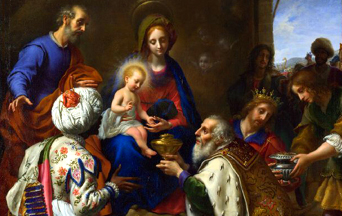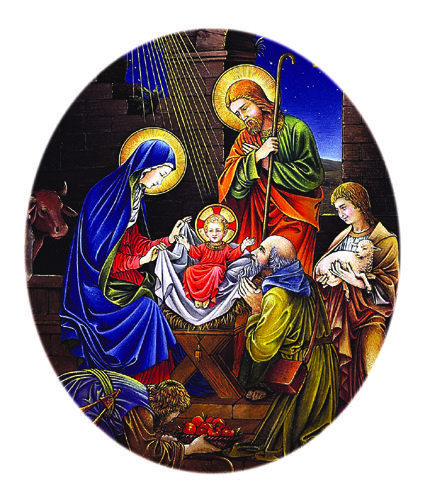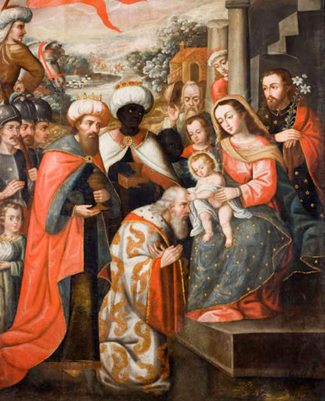
Approach the crib of the Child God with me. Let us imagine the arrival of the Magi Kings at the manger, after having followed the Star of Bethlehem with their caravans and treasure-laden animals. These sovereigns—King Balthazar, King Melchior and King Gaspar—offer the Child Jesus gold, frankincense and myrrh, in adoration.
Looking at the God Child, we pause and consider His infinite grandeur, His accessibility, as well as His infinite compassion. We then ask ourselves, which of these three Divine qualities draws us closer to Him.
Dignity of the Child Jesus and His Most Holy Mother
As we consider the infinite greatness of His birthplace, let us imagine a spacious grotto as high as a cathedral, with some of the stones arranged, as if by angels, in such a way as to remind us of the arches of the gothic cathedrals of the Middle Ages.
We can also imagine the manger that served as a cradle for the Child God, the roughness of the wood sanctified by His Divine Presence. Placed at the focal point of the grotto with a heavenly, golden light hovering over Him, the manger is a majestic throne.
While still a newborn, the Divine Child lay in His crib with the majesty of a true King: King of all majesty and all glory; Creator of Heaven and Earth; God incarnate made man. From the first moment of His being, while “cloistered” away in His Mother’s womb, He had more majesty, grandeur, strength and power than all men throughout the history of mankind. Knowing all things incomparably more than any scientist, the Christ Child had inscribed in every physical feature that majesty made of wisdom, holiness, science, and power.
 Learn All About the Prophecies of Our Lady of Good Success About Our Times
Learn All About the Prophecies of Our Lady of Good Success About Our Times
Imagine we are seeing all this mysteriously expressed on that Boy’s face. At times, as He moves, that movement reveals His kingly bearing. When He opens His eyes, we know we are in the presence of the Wisdom of the Ages.
A whole atmosphere of holiness surrounds those who approach Him. The very air one breathes has such purity that people do not even approach the place without asking forgiveness for their sins; but at the same time, the holiness emanating from the manger makes them want to amend their lives.
Imagine also Our Lady at the foot of the Child Jesus. She is truly a Queen. Her dignity and grandeur are so naturally a part of her being that even without wearing noble-looking garments, her dignity shines throughout the grotto.
Majesty Exuding From Sanctity
From where does all this majesty come? Sanctity.
Let us shift our meditation momentarily to consider a more recent example of this type of majesty. We will turn to Saint Thérèse, the Little Flower. It is written that even as a child she was so dear and imposing that her father called her “my little queen.”
During the process of her canonization, the gardener of the Carmel of Lisieux reported that he once saw a nun working with her back to him: she was Saint Thérèse. The devil’s advocate1 then asked, “How could you know she was Sister Thérèse when she had her back to you?” The gardener’s response was very significant: “I knew it through the majesty of her bearing, for no other nun had such majesty.”
If Saint Thérèse was like that, what would Our Lady be like?
Imagine the Mother of God kneeling before her Child’s crib. She is so majestic, transcendent and pure, praying to the Child God. Invisibly, angels sing songs of glory and the whole atmosphere is permeated with so much sanctity as to transform the poverty of the stable into a royal court.
A God So Small, Yet Infinite; Infinite, Yet So Small!
Now we approach the manger, feeling the greatness of the Divine Child. As Catholics, we are worshiping all that is noble, pure, holy and steadfast, to fight and sacrifice all for the glory of God. The Boy before us mysteriously draws to Him all the goodness and grandeur that flow from Him and yet are but reflections of Him. For is it not true that all forms of purity, all forms of holiness, only exist because of His holiness?
Thus, fending away from us sin, error, disorder and chaos, we do not even dare to raise our eyes to that magnificent scene of the Nativity in which order, hierarchy and splendor permeate everything.

Though Majestic, He Beckons Us to Come Close
Now let us imagine another aspect: His infinite accessibility.
Imagine the Baby Jesus immensely approachable. This King, so full of majesty, at a certain moment opens His eyes to us. We notice right away that His most pure, highly intelligent and penetrating gaze meets ours. He immediately sees the deepest of our faults, but also the best of our qualities. At that moment, He gently touches our soul just as He moved Saint Peter during His Passion.
The Gospels tell us that the way Our Lord looked at Saint Peter was such that the latter went out and wept bitterly. Throughout his life, the Prince of the Apostles never forgot the touching gaze that continually caused him to repent of his three-fold denial of his Lord.
It is only natural that this gaze would provoke in us a deep sorrow for our faults. Giving us a knowledge of our failings, it inspires us with a horror for our sins.
But all is not lost!
Just when we fear we cannot withstand that gaze, the newborn Redeemer also manifests His love of our qualities. He will always love that which He, in His infinite goodness, created. It is a love He dedicates to us despite our faults, because we were created by Him and are destined to a degree of holiness and perfection that He Himself placed within us. He knows our potential for greatness and that is what He loves.
Seeking the True Joy of Christmas
And when we least expect it, by a kind entreaty of Our Lady, He smiles. Despite all His majesty, with that smile we feel the distance disappear, forgiveness invades our soul, and we are drawn to Him; and thus drawn, we walk up to stay with Him. We have determined that we will never leave the Child God’s side. The Divine Child affectionately embraces us and pronounces our name, in the most clear and loving tones to ever fall upon our ears.
“My dear one, I do love you so much! I wish you so many things and forgive you for so many others! Do not think about your sins any longer. From now on, think only about serving Me. And throughout your life, when you have any doubt, remember the sympathy, kindness and good pleasure I am now showing you. Have recourse to Me through My Mother. Through the voice of My Mother, I will always hear you. I will be your refuge and your strength, and these will take you to heaven, to reign at my side for all eternity.”
Infinite Compassion
Now imagine the mercy of the Child Jesus. This divine mercy is most evident when He seeks our good and discerns what is good and bad in us. In His mercy, the Child God considers the miserable condition of every man traveling through this vale of tears.
The mercy of Christ analyzes the sorrow and suffering that each of us brings along—past, present and future suffering; the grief and sorrow that you may feel at this very moment. He already knows all of this because He is God. And He also sees the risk that our souls run of going to hell. As Catholics, we know that on his earthly journey man is exposed to the very real danger of losing his soul for all eternity.
Also, imagine the Child Jesus looking at Purgatory and the torments that await us there if we are not entirely faithful.
His Face now shows a look of sympathy and deep participation in our pain; a desire to remove that pain as much as possible in view of our sanctification. In His infinite mercy, this Infant desires to give us the strength to withstand whatever pain is necessary for our sanctification.
In Him, we see that which so greatly consoles the human soul: perfect compassion.
It is part of our human nature for us, when we are suffering, to feel consoled at seeing that someone has pity on us. Compassion thus lessens suffering by sharing in it. Man is made in such a way that when he is happy and communicates his joy, that joy is doubled; and when he is sad and communicates that sadness, the sorrow is divided.
So also are we made stronger when we discern in the face of the Child God that most perfect compassion.
Stop and See
In all the sufferings of our life, when the cup of our trials is bitter, we should repeat, through Our Lady, His prayer: “My Father, if it be possible, let this cup pass from me, but let Your will be done, and not mine.”
At any time we can ask that the pain cease. However, if it is His will that we drink from a bitter cup as He did, we are certain that our pain will find His compassion. In addition, He will tell us: “My son, I am suffering with you! Let us suffer together, for I suffered for you; a moment will come when you will forever participate in My joy.” And we can be sure that the compassionate gaze of Jesus will not leave us a single moment of our existence.
Therefore, throughout the ups and downs of everyday life, we should retain this threefold memory—the Child God’s infinite majesty, His infinite accessibility, and the boundless compassion He shows towards us. This should be a living memory, one which composes in our imagination an accurate image, which moves our soul.

Three Crèches for the Child God
Being like us in all things except sin, Our Lord’s human nature is comprised of perfections and moods that existed according to the circumstances of His life, and all of them perfect. He was full of majesty, fully accessible, ready to listen and to have compassion on men from the moment He became incarnate.
It is only natural that one or another part of Christ’s human nature would be more obvious as different people, in different states of soul, approach Him.
To better assist in a meditation like the one we just shared, it would be very inspiring if we were able to set up three crèches in a church, on three different altars. On each of these altars the figures and the whole atmosphere would signify each of these aspects, thus making it easier for souls to meditate on the Child’s mood that touches them the most.
In this way our meditation on Christmas would be based on a very sensible retelling of the scene, which can more easily touch us and stay with us as we make our way out of the Crèche and back into the world.
